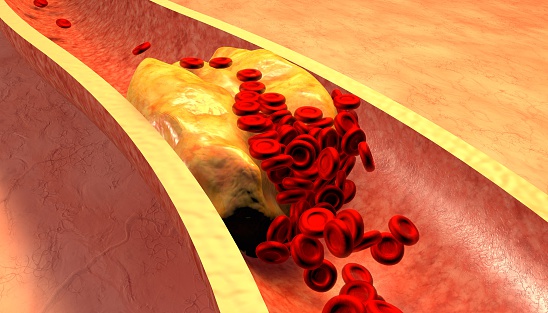
Atherosclerosis is a condition in which the arteries become hardened and narrow due to excess plaque buildup.
When this occurs, blood flow becomes disrupted, which can lead to heart complications and poor overall health as other parts of the body require a blood supply to function properly. Cardiovascular disease is one of the possible consequences of atherosclerosis.
Atherosclerosis sets in when the endothelium, a layer of cells lining the arteries and keeping them smooth, becomes damaged due to LDL cholesterol accumulation along the artery walls.
The body has its own way of removing this excess cholesterol by sending out white blood cells, but the cells can get stuck to the affected area, resulting in further plaque buildup.
Types of atherosclerosis
There are four types of atherosclerosis: coronary artery disease, peripheral artery disease, carotid artery disease, and kidney disease. The types of arthrosclerosis get their names from the arteries affected in each condition.
In coronary artery disease, atherosclerosis affects the coronary arteries.
Peripheral artery disease occurs in the legs, arms, and lower body, leading to problems with circulation in the extremities.
Carotid artery disease affects the arteries in the neck that supply your brain with blood. The condition results in restricted blood flow to the brain.
Kidney disease is the reduction of blood flow to the kidneys due to atherosclerosis of the renal arteries.
Atherosclerosis causes, symptoms
As mentioned, atherosclerosis is caused by the plaque buildup in the arteries, making them stiff and hard, reducing blood flow to other parts of the body. LDL cholesterol is a large contributing factor to atherosclerosis, as it builds up along the artery walls. White blood cells intended to clean up the buildup can get stuck, too, further contributing to the problem.
Other causes of atherosclerosis include high blood pressure, smoking, and high levels of glucose in the blood (unmanaged diabetes). Genetics and air pollution can contribute to atherosclerosis as well. Individuals who have a sibling or parent with atherosclerosis are at an increased risk for the condition.
Symptoms of atherosclerosis vary depending on the type of the condition.
Carotid artery disease:
- Weakness
- Breathing difficulties
- Headache
- Facial numbness
- Paralysis
Coronary artery disease:
- Vomiting
- Extreme anxiety
- Chest pain
- Coughing
- Feeling faint
Kidney disease:
- Loss of appetite
- Swelling of the hands and feet
- Difficulty concentrating
Peripheral artery disease:
- Hair loss on legs or feet
- Erectile dysfunction
- Numbness in legs
- Changes in skin color
- Thicker toenails
- Leg weakness
Atherosclerosis treatment, diagnosis
There are numerous ways to diagnose atherosclerosis. For starters, your doctor may perform a blood test to measure fat, sugar, and protein content in the blood. High levels of these may indicate the existing plaque buildup in the arteries.
A physical exam will also be performed to listen to your heart and blood flow, check for a weak pulse, which is a sign of poor blood flow, check your blood pressure, and check for any wounds that may not be healing due to reduced blood flow.
An ultrasound can also be utilized to get an image and check for changes in blood pressure in different areas in the body. Lastly, your doctor may request a CT scan to get detailed images of the inside of your body.
There are three main types of treatment options when it comes to atherosclerosis: lifestyle changes, medication, and surgery.
Prescribed medication works to lower blood pressure and cholesterol, and even prevent blood clots (known as antiplatelet drugs).
Lastly, surgery can be used to open up and widen the arteries in order to resolve the blockage.
Lifestyle changes for atherosclerosis
Because many habits contribute to hardening of the arteries, modifying your lifestyle can help improve the condition. This involves eating healthy, reducing sodium and saturated and trans fats in your diet, not smoking, and exercising regularly.
Research shows that 90 percent of heart attacks are due to the following risk factors:
- Smoking
- High blood pressure
- Diabetes
- High cholesterol
- Obesity
- Excessive consumption of alcohol
- Sedentary lifestyle
- Stress
- Insufficient intake of fruits and vegetables
By controlling these risk factors, you can reduce your risk of atherosclerosis and the associated complications.
Depending on your risk factors and current condition, your doctor will recommend the best treatment, which will often combine lifestyle factors with medical intervention.
Atherosclerosis vs. arteriosclerosis
Although atherosclerosis and arteriosclerosis share some similarities, these two are not the same. Both conditions involve hardening of the arteries, but for different reasons. In arteriosclerosis, hardening of the arteries occurs due to loss of elasticity in the arterial musculature. This is usually age related, and when elasticity is lost, thickening occurs and may lead to hardening.
In arteriosclerosis, the hardening of the arteries causes blood pressure to go up because the blood flow cannot pass through as effectively, worsening the disease over time. The arteries do not become narrow as they do in atherosclerosis, but they simply are not as flexible, which negatively impacts the blood flow.
Atherosclerosis can be more life-threatening than arteriosclerosis, but both conditions are serious as they cause your heart to work harder in order to keep the blood traveling throughout the body.
Lastly, unlike atherosclerosis, which has numerous treatment options, there is no cure for arteriosclerosis, as there isn’t a way to improve artery elasticity as of yet.